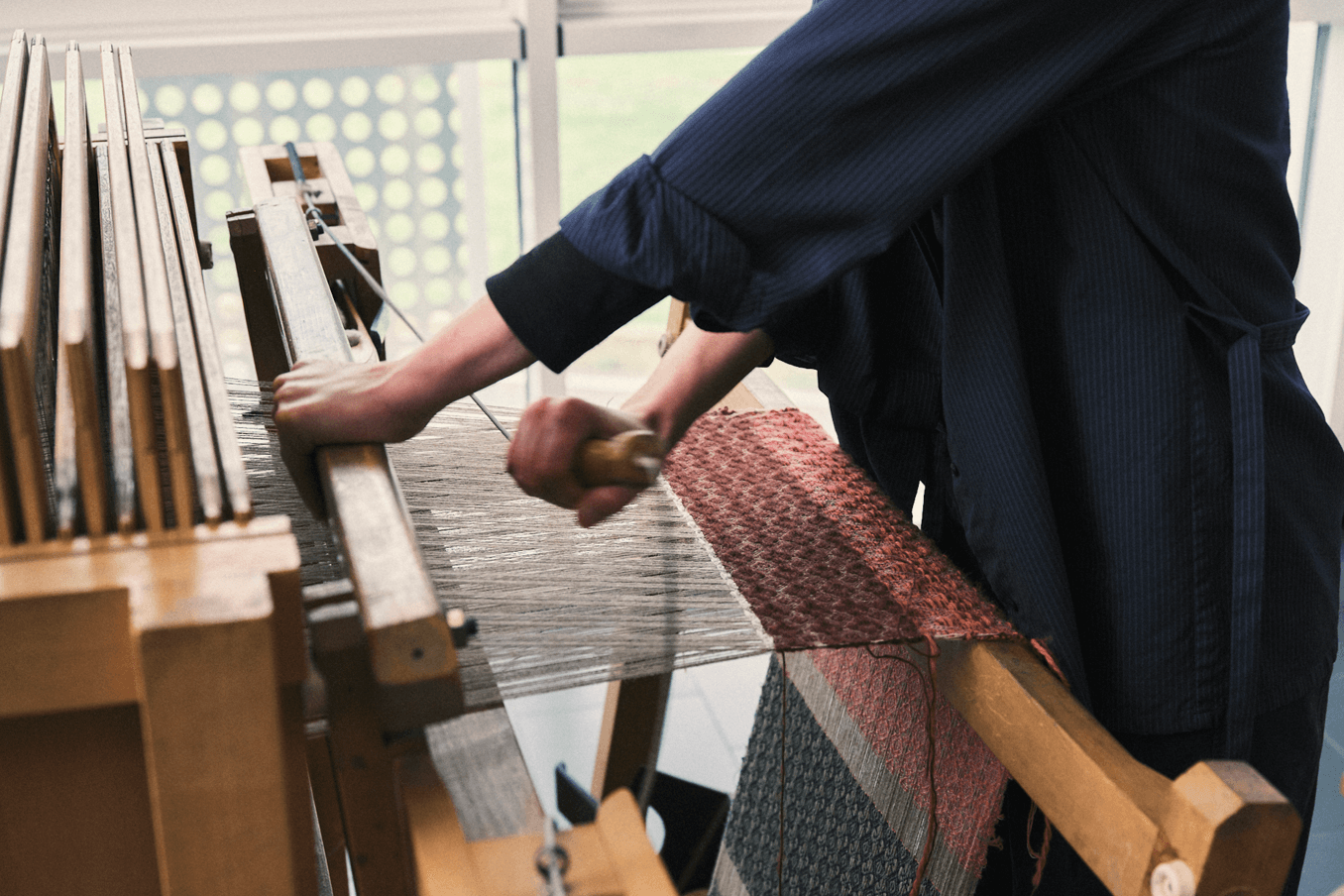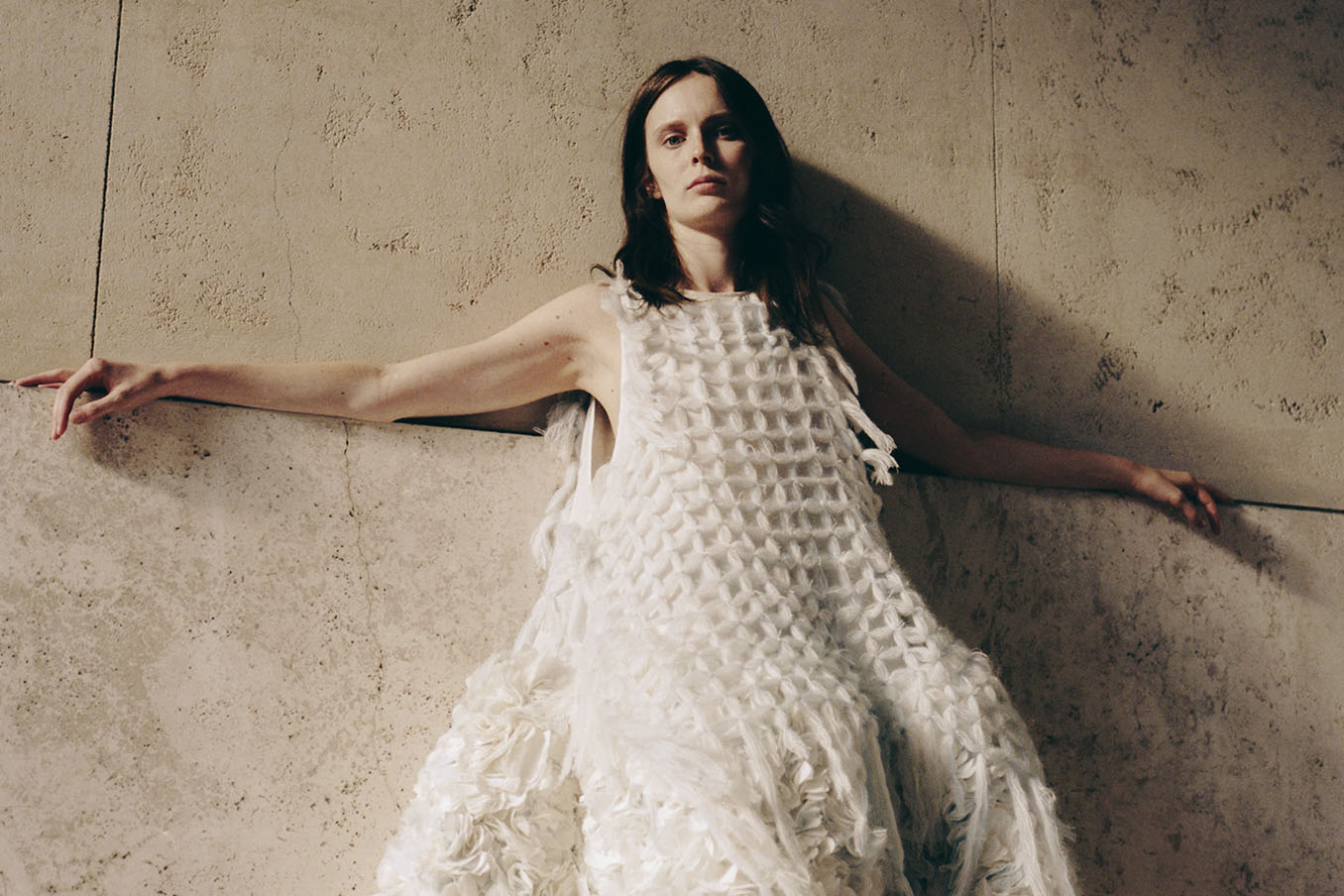Trend forecasters, Li Edelkoort and Philip Fimmano, announce the winner of the 11th edition of the Dorothy Waxman International Textile Design Prize: Verónica Santamaría Querubín, from Colombia, a former student of Polimoda’s Master in Textiles from Farm to Fabric to Fashion.
The prize has been awarded for her collection titled, “The Daughter of the Snake”; fully made from natural fibers using manual techniques, it explores a connection between Latin American material, like the chambira fiber from the Colombian Amazon rainforest, and Italian fibers, like linen and silks. In Amazonian cosmology, the snake is a powerful figure that embodies metamorphosis and acts as a transformative force. In this interview, Verónica shares how, through creating her collection, she was able to become “the daughter of the snake”, allowing herself to be carried by the flow of her craft, accepting change as something inevitable and necessary, and ultimately unveiling the potential of textile design to have a profound effect on individuals and the collective.
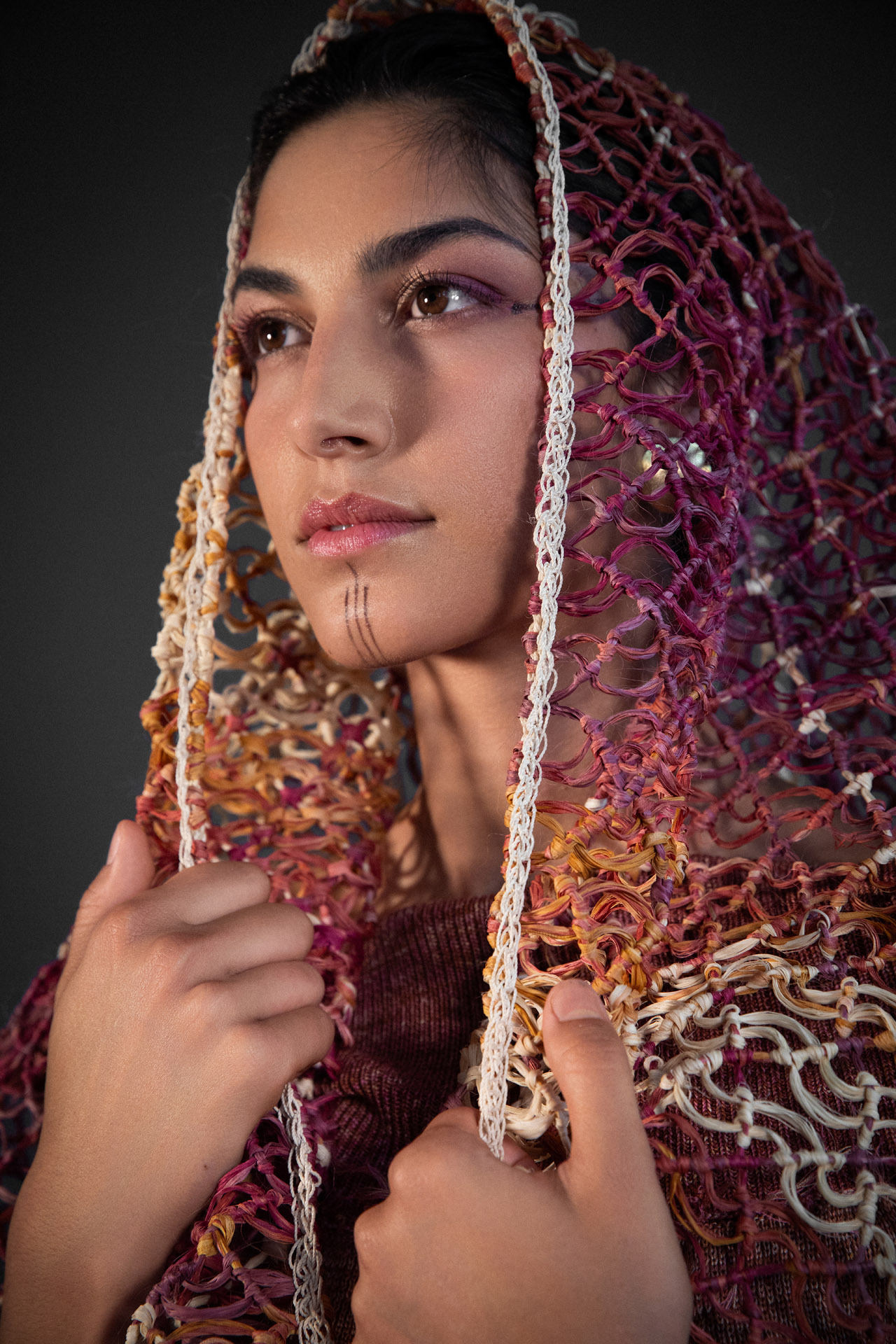
What materials did you use for your collection? Could you please explain the innovative and sustainable approach to your material choices.
My material universe is rooted in fibers that carry both history and geography within them. Chambira fiber from the Colombian Amazon rainforest became the heart of this collection, not only for its strength and versatility, but also for the ancestral energy it embodies: an amulet of protection, a thread that connects body, territory, and spirit. Alongside it, I worked with Colombian silk raised on small farms in Popayán, Cauca, yanchama bark cloth, natural seeds and beans, and a chromatic palette extracted entirely from Latin-American dye plants such as cochineal, annatto, marigold, brazilwood, logwood, and turmeric. I complemented these with Italian linens and silks, weaving together my Latin American roots with my present in Europe.
For me, these are living fibers. They come from the earth, they breathe, and they carry within them a singular genetic memory that makes them unique. What makes this approach innovative is not simply the use of natural materials, but the way I allowed each one to guide the process, often pushing them beyond their conventional applications. The spinning wheel, the loom, the knitting machine, and my own hands became tools of dialogue with the fibers, transforming them while respecting their essence. The interplay of hand-spun threads, contrasting thicknesses, and variations of shine and texture created a material universe that feels both rich and alive.
Sustainability, in this sense, was never a separate goal but an intrinsic logic: every material was chosen for its origin, its relationship to land and community, and for its ability to be transformed without breaking its spirit.
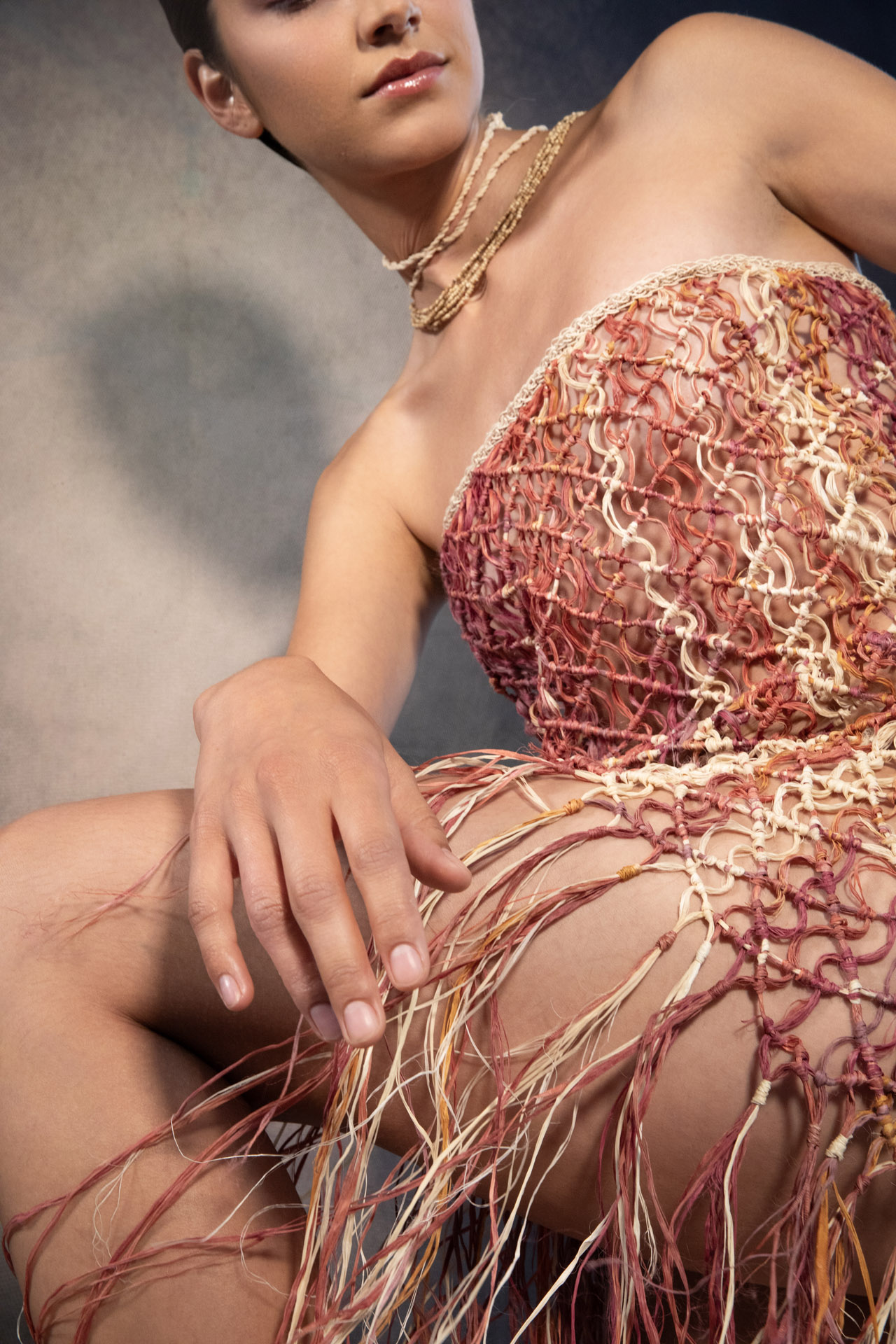
You describe fiber and color as a ‘healing experience.’ Can you explain what you mean by that—what did this collection heal or transform in you?
Working with fiber and color has always been, for me, an intimate, introspective, and meditative process, a practice that allows me to step into a different space-time, a dialogue between my hands and the material. In this project, the healing came from learning to let go of control. When I allowed a plant to dictate its hue, when I let a fiber decide its tension, I opened within myself a space for acceptance, patience, and joy.
Healing also came through my encounters with the ancestral knowledge of Amazonian women artisans. Going back to the land, cultivating color with my own hands, became a restorative act, because the earth itself holds curative powers. Entering these spiritual dimensions, so often ignored by Western society, revealed to me that textiles are also part of a cosmogony, inseparable from care, health, and well-being.
Chambira, in particular, became more than a fiber. It is a protective amulet, a symbol of certainty in a world full of uncertainty. Through it, I found a place where, in the midst of chaos, I could hold on to hope.
The process became a mirror: as the fibers transformed through dye or weave, so did I. This collection taught me to embrace uncertainty, to celebrate imperfection, and to honor intuition as much as technique. That is the healing dimension: it reminded me that making can restore balance, aligning body, mind, and spirit.
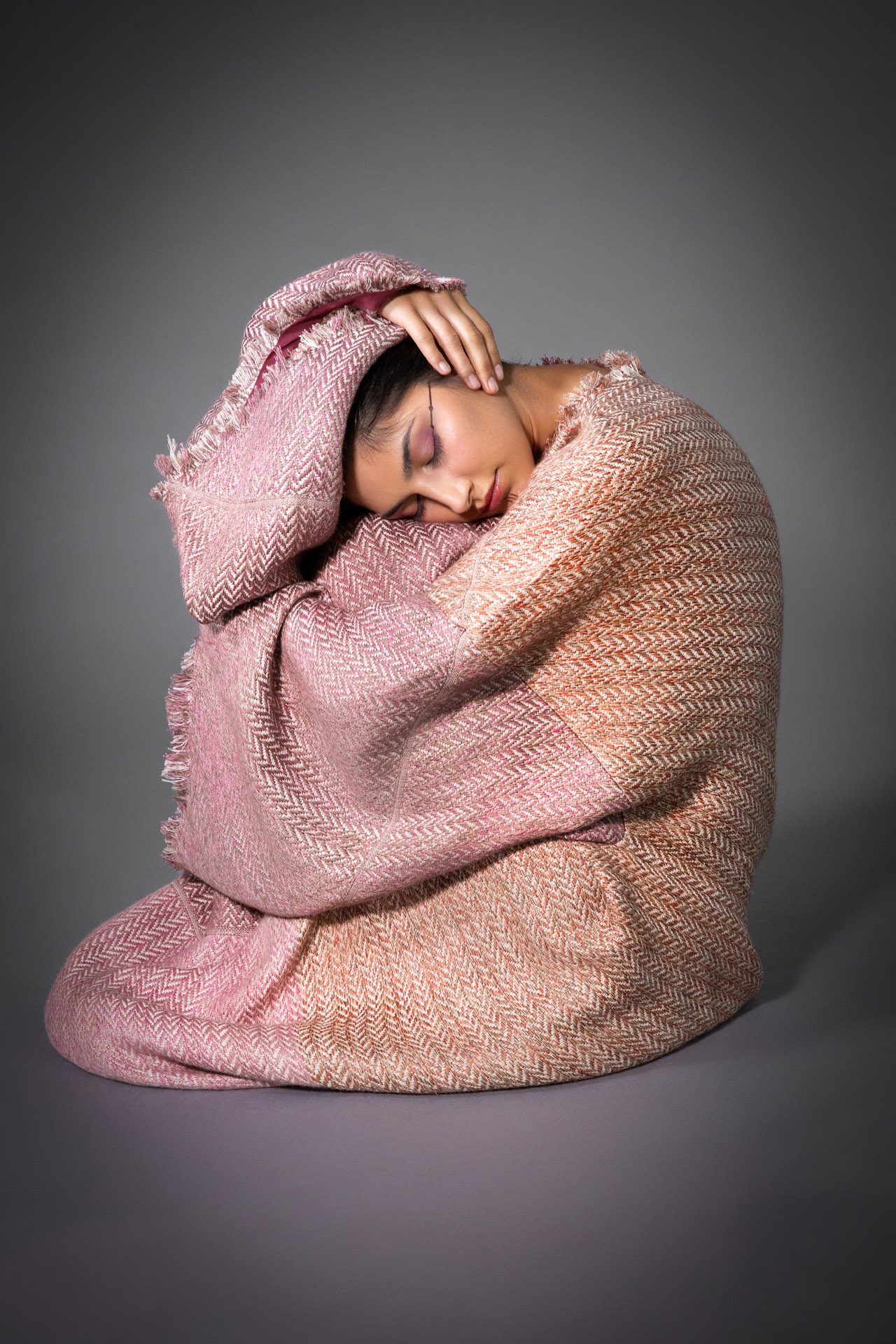
The chambira fiber is called ‘the daughter of the snake.’ What does that symbolism mean, and did it shape this collection?
The name “daughter of the snake” speaks of transformation, strength, and renewal. In Amazonian cosmology, the snake is a powerful figure of movement and metamorphosis, and chambira embodies that very energy, it twists, stretches, adapts, and resists.
For me, working with chambira meant entering into direct dialogue with that transformative force. It pushed me to experiment, to attempt techniques I had never tried before, and to embrace risk. Each piece became not only a textile, but also a gesture of change—an act of shedding an old skin to make space for something new.
In that process, I too became the daughter of the snake. The fiber transformed me as much as I transformed it. The serpent revealed itself as both protector and guide, reminding me of the wisdom of textiles, their long, complex, and essential processes. Allowing myself to be carried by the rhythm of the craft, I discovered that change is not only possible but necessary. Like the snake, I learned to renew myself, to let go, and to grow through making.
How did your studies at Polimoda contribute to your winning collection?
My Master’s program offered me a radical lens through which to see textiles, from seed to finished garment. What marked me most was the opportunity to study fibers in their entirety, beginning in the field and ending in the atelier. This holistic approach reshaped my way of thinking: instead of seeing textiles as a medium for design, I began to see design as a way to honor the textile itself.
I owe my approach to what I can truly call the program of my dreams: the Master in Textiles from Farm to Fabric to Fashion, founded by Lidewij Edelkoort and Philip Fimmano. From day one, it transformed the way I approached and understood textiles. The program was carefully tailored, material-centered, and rooted in a profound respect for craft. It also allowed me to incorporate tools from anthropology and archaeology, which gave rigor and depth to the conceptual framework of my project.
Above all, my mentors were essential. My design teacher guided me with care and sensibility throughout the process, while I had the most extraordinary weaving professor I could have wished for. And the list is long, each one of my mentors was simply exceptional. Learning from such extraordinary people was a true privilege, one that shaped both my technical development and my creative voice. My peers and my leading teacher were pillars of this process, their talent, devotion, and shared love for the craft transformed the atelier into a safe sanctuary of creation, a fertile ground where ideas could breathe and grow.

The luxury of working on the extraordinary Dobby hand-weaving looms made in Prato at Polimoda was a treasure in itself, a space where material, time, and craft converged. I was able to immerse myself deeply in technically demanding disciplines such as weaving and knitwear, embracing a learning curve as intense as it was rewarding. Encounters with inspiring people from the textile industry, along with journeys to Holland and Japan, expanded my vision of fibers, raw materials, and the countless ways to approach craft. The staff at Polimoda became my guardians of this journey, always caring, attentive, and generous with their guidance.
This program is at the core of my practice: it taught me to look to the land, to honor the fiber, and to let the material lead. Without my mentors and the education I received, this collection would not have been possible. For all of this, I remain deeply and eternally grateful to my unique and groundbreaking program, Textiles: from Farm to Fabric to Fashion.

You achieved under 5% waste using only manual techniques. What did that process teach you about the relationship between sustainability and slowness?
Working manually forced me into a rhythm closer to the material’s own pace than to mine. It revealed that slowness is not a limitation, it is a form of care. By dedicating time to each step, and respecting the natural boundaries of the fibers, waste diminished naturally. The process taught me that sustainability is not only about efficiency, but about presence. When you are attentive, patient, and willing to move at the speed of the fiber, you discover that almost nothing is disposable. Every fragment holds potential, every offcut can be reimagined.
Creating my own textile surfaces meant that cutting and experimenting with complex patterns became a profound decision, one that could never be taken lightly. To sacrifice a piece was to sacrifice time, care, and intention. When you enter into an intimate, emotional relationship with your materials, waste becomes an act of violence, a loss of something precious. There is so much time, affection, and patience in each fiber, each surface, each detail that the relationship with the craft and with the garment itself changes. It becomes devotion, an absolute respect for every stage of the process.
I believe this is the disconnection we face today in the fashion system: when we no longer know how things are made, the hands, the time, the dialogue, all become mere inputs, and care disappears. In that absence, discarding feels natural. I believe here lies a revolution, the revolution of care for craft and materials. If we redefine production chains and the relationships we build, we can create from places that are human, genuine, and honest. Caring is at the foundation of everything I do. Beauty is born there.
Now that you’ve won the Dorothy Waxman Prize, what do you hope this collection says to the fashion industry about the future of textiles?
I hope this collection stands as a reminder that textiles are not mere surfaces to be consumed, but living entities that carry memory, territory, and spirit. The future of textiles lies in reconnecting with their origins, honoring the plant, the animal, and the human hands that bring them to life, I wish people could see the process of making as a treasure itself.
Innovation does not always mean speed or technology; it also means intimacy, reciprocity, and respect. I hope the fashion industry embraces the power of slowing down, of working with honesty and intimacy, to create aesthetics that are not only beautiful but deeply meaningful.
In narrative, in spirit, and in the human relationships that emerge through making, there is a value too often overlooked: the exchange of ancestral knowledge, the mastery of craft, and the reverence for time as the most precious gift life offers. Textiles are more than material; they are a living layer that adorns, covers, and protects us. I believe in textiles as a transformative force, and in craft as a path to reconnect with ourselves and discover rhythms of care, balance, and well-being.

What are your plans for your future career? What are the professional possibilities open to textile students?
For me, textiles are not just a discipline, they are a home I belong to, and I always return to. My future lies in continuing to explore the multiple languages textiles can speak: fashion, art, interiors, even ritual. What matters to me is to keep nurturing the relationship between body, fiber, and territory. I hope to find a place where I can create from a space of care, slowness, and joy.
I am infinitely fortunate to say that my work is my life. I love deeply what I do, and I wish not to sacrifice that wellbeing to survive the dynamics of a system that prioritizes speed and quantity, over meaning and time. I hope more and more of us will commit to change, believing that the joy of making exists and that honest working relationships matter and are possible. I may sound idealistic, and reality may prove otherwise, but I believe radical change lies in refusing to give up hope.
For textile students, I like to believe the field is wide open. The material world is calling for caretakers, people who can imagine sustainable futures through practice. Whether through design, research, or collaboration with artisans, there are endless ways to engage. Personally, I wish to keep weaving bridges, between geographies, between tradition and experiment, between personal stories and collective memory. Through the example of my mentors, I have learned that making from a sincere and meaningful place is possible. At times it is difficult, and at times it feels like forging a path where none exists, but my commitment to the land, to hands, to time, is something I make without hesitation. I believe in textiles, whatever it takes.
CREDITS
Cover image
- Collection “The Daughter of the Snake” by Verónica Santamaría Querubín
- Photo by Natalia Peralta
- Hair & Make-up by Natasha Leslie Wellington Dini
